Lead
In history class we learned about the Bronze Age; this was a breakthrough period for artisans and craftsmen. Next up was the Iron Age, when manufacturing flourished. At this time I’d like to welcome you to the Lead Age, an Unfortunate Age for you, but one in which kidney doctors and cardiologists like me have flourished.
Mother Nature did not design us to take in or to be able to process Lead. Thus in humans, Lead is a toxin; there is simply no “safe” or “normal” level of Lead. True, the ancients mined Lead, initially as a byproduct in the process of Silver extraction, and later to be used in the manufacture of weapons and water piping. The Romans made extensive use of Lead in daily life, including cosmetics, plumbing, and painting. Roman wine was contaminated with Lead due to the practice of simmering grape syrup in Lead vessels to enhance the flavor. It has been speculated that infertility and mental infirmity due to Lead poisoning caused by widespread consumption of Lead contaminated wine played a role in the decline of the Roman civilization (Nero let Rome burn not because he didn’t care, but because he couldn’t care – his brain was too addled by Lead to care).
At the peak of the Roman Empire, some 2000 years ago, worldwide production was 10,000 tons; today 1,000,000,000 tons per year of Lead is extracted from the Earth’s crust. We’re also using Lead differently. Lead in plowshares doesn’t hurt us, while Lead taken orally poisons our system, and Lead emitted into the atmosphere returns to our food and water. Between 500 and 1500 AD, worldwide Lead emissions ranged between 500 and 1500 tons per year. Worldwide Lead emissions peaked in the 70’s at about 400,000 tons per year, and this Lead is now returning to haunt us – our cellular biochemistry is now in its Lead Age.
Where does this Lead come from? Lead has been removed from gasoline (but that has not removed from you the Lead that you absorbed from the gasoline – more on this later). Today, our Lead exposure comes primarily from paints, batteries, industrial emissions, and drinking water that passes through Lead-lined pipes. A “healthy” man of today has 100 times the bone Lead content as did a truly healthy man of 100 years ago. I put “healthy” in quotes, because all men of today harbor Lead, and Lead content is continuously and tightly linked to hypertension and kidney disease, even Lead levels in the “safe” range. Children are more susceptible to Lead toxicity than are adults, and here the problem is not high blood pressure, but poisoning of the brain and other components of the nervous system. While adults absorb 5 - 10% of the Lead that they ingest, children will absorb 25 - 40%. While in adults the brain is fully formed up (but not always used), in children it is developing, and mistakenly incorporates into nerve tissue the Lead that is taken up from the GI tract.
Government agencies such as the Center for Disease Control (CDC), have been monitoring the Lead situation and have published guidelines as to what is a “safe” or “acceptable” level of Lead in the blood of a child; as short as 20 years ago a blood Lead level of 80 ug/dl was considered to be “safe”. Well, poisons are poisons, and poisons are poisons at any level. As more was learned about the toxic effects of Lead in humans, especially in human kids, the “safe” level has been steadily lowered, to the current “safe” level of 10 ug/dl.
But 1 in 20, around 890,000, preschool children in the United States have a blood level above this “safe” limit of 10 ug/dl, and in some Northeastern cities, 35% of the kids will register Lead levels above the 10 ug/dl standard. Each year, about 200 American children die from Lead brain poisoning, 800 sustain permanent retardation, and 3,200 have temporary mental impairment – and we had no idea, that is until recently, how children with “subtoxic” blood Lead levels were faring. Now we do – a recently published paper demonstrated that children with blood levels of 10 ug/dl, the upper limit of the “safe range”, have IQs 7.5 points below those of kids whose blood Lead levels are 0-1 ug/dl. Is your child having trouble in school? 7.5 IQ points is huge. Girls with Lead levels of 3 mcg/dl demonstrate delayed onset of puberty. Can delayed onset of puberty be good for them? The nightly news gives us reports of high school children who just don’t seem to care about the lives of others – I just don’t remember this occurring when I was growing up. Have we let the “safe” levels of the neurotoxins Lead, Cadmium, and Mercury turn the youth of today into 21st century Neros? Remember, a poison is a poison, and a poison is a poison at any level.
Now, assuming we make it through childhood with an intact brain, what affect will Lead have on us as adults? Lead can still hurt us in many ways, but in this section I’d like to focus on the link between adult Lead burden and the risk of hypertension and kidney disease. Post-menopausal hypertension will be presented as a classic example. In discussing Lead, we must first realize that the blood Lead level is not a good marker of one’s intracellular, or total body, Lead burden. Lead crosses the cell membrane, and just like Mercury and Cadmium, intracellular Lead binds to sulfhydryl groups on critical intracellular structures in a nearly irreversible fashion, “locking” itself in. If Lead exposure is ongoing, as it is in the average American, then the Lead content of the average American will steadily increase (your blood Lead level reflects only recent exposure – it has diagnostic value in children, where ongoing Lead exposure typically reflects body stores, in adults in industrial settings, or to reflect the amount of Lead that is being released from bone, such as occurs to explain post-menopausal hypertension).
The Normative Ageing Study correlated bone Lead levels in men with their risk of developing essential hypertension (we call it essential hypertension, because we’ve never been able to explain why our blood pressure rises with age). Bone Lead content can be measured with an X-Ray fluorescence technique (here we must realize that in children and adults, 75% and 95% of total body Lead will be found in bone). Lead binds to sulfhydryl groups within cells, including bone cells; thus Lead will “lock itself in” within bone cells, and will remain in bone until the bone cells turn over, which occurs only once every 6 years. Therefore, bone Lead reflects your long-term exposure to Lead, and bone Lead reflects your total body burden of Lead. 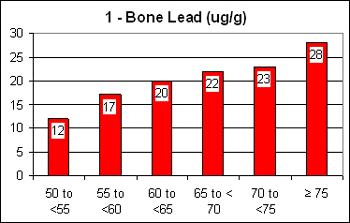
During the past two decades, American adult blood Lead levels have fallen by 90%, largely as a result of the elimination of Lead from gasoline and the reduced use of Lead soldered cans in food processing, but as you can see from chart 1, which depicts bone Lead level in relation to advancing age, this public health maneuver, while a good idea, hasn’t lead to a reduction in our total body Lead burden. Remember, Lead “locks itself in”, and Mother Nature isn’t particularly good at pulling it out. The Normative Ageing Study researchers found a direct link between body Lead burden, as reflected in bone Lead content, and one’s risk of developing high blood pressure. Specifically, as bone Lead rose from 8 ug/g (the mid-range value in the lower quintile, the 20% of the population with the lowest bone Lead levels), to 37 ug/g (the mid-range of the highest quintile), one’s risk of developing high blood pressure increased by 50%. In studies that look at risk factors for hypertension (conditions associated with an increased risk of developing hypertension), age is always the most important predictor, but those studies did not take into consideration one’s body burden of Lead. In the Normative Ageing Study, which did, age was not a predictor of hypertension after factoring in body Lead burden. The point here is that ageing does not cause hypertension; there is nothing “normal” about the rise in blood pressure that occurs with age in Americans. Advancing age, in Americans, simply reflects the length of time that you have been exposed to toxic metals such as Lead, Cadmium, and Mercury, toxic metals that accumulate, toxic metals that, by poisoning enzyme systems, causing free radical stress, and pushing out nutritional minerals, cause hypertension, kidney disease, and cardiovascular disease. This can all be prevented!
Let’s look at the relationship between bone Lead, blood Lead, and blood pressure in post-menopausal women. In healthy men and in healthy pre-menopausal women, bone mineral density is relatively static; bone cells turn over only once every six years. Following menopause, a women’s bone mineral density will fall; there is a net demineralization of bone. Bone cell turnover is thus markedly increased, creating a situation where the soft tissues of the body could be “contaminated” with Lead that has been storing up in bone for decades. Does this actually happen?
The Normative Ageing Study, which looked only at men, demonstrated a direct link between bone Lead content and subsequent risk of hypertension. The Nurses Health Study, which looked at predominantly pre-menopausal women, demonstrated that as bone Lead increased from the 10th to the 90th percentile, a woman’s risk for hypertension doubled. Our next study looks at the relationship between blood Lead (not bone Lead) and risk of hypertension in women in their 40’s and 50’s. 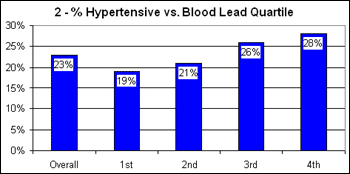
The average blood level for the entire group was 2.9 ug/dl, and the mean values for the quartiles of blood Lead ranged from 1.0 in the lowest quartile (lowest 25% bracket) to 6.3 in the highest quartile (4th quartile range 4.0 to 31 ug/dl). Thus nearly all of these healthy 40 to 59 year-old American women had blood Lead levels in the “normal” range, so what’s the problem? The problem is that while 23% of the entire group had high blood pressure, only 19% of the women in the lowest quartile for blood Lead had high blood pressure, while 28% of the women in the upper quartile for blood Lead were hypertensive (chart 2). After adjusting for differences in other factors that might affect one’s risk for hypertension, the researchers concluded that women in the 3rd and 4th quartiles for blood Lead were 30% and 40% more likely, respectively, to develop hypertension in comparison to women in the lowest quartile for blood Lead. If we look only at diastolic hypertension (the lower number), we see essentially a “dose-response” relationship between blood Lead and this condition (see chart 3). 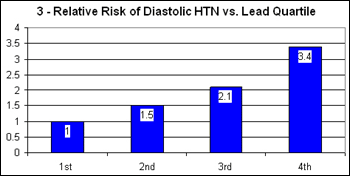
Now let’s look at the association between blood Lead level and risk of hypertension, as a function of menopausal status. In women pre-menopause, there was a relatively weak relationship between blood level and overall risk of hypertension, while the link was much stronger in post-menopausal women. When compared to women in the lowest quartile for blood Lead, post-menopausal women in the 2nd quartile were three times as likely to have an elevated blood pressure, and women in the 3rd quartile were 2.7 times more likely. The association was even stronger when diastolic hypertension was viewed separately (chart 4); again a Lead “dose-response” curve is generated. In other words, if you are a post-menopausal women, and your blood Lead level is in the upper quartile, above 4 ug/dl (and remember that < 10ug/dl is considered to be “safe”), then your risk of developing hypertension is 8 times that of a post-menopausal women with a blood Lead level of <1.7. The message here is that Lead is a toxin at any level. This eight-fold increased risk for hypertension with a blood Lead level in the “safe” range is similar to the 7.5 point IQ drop associated with a “safe” blood Lead level in our kids! 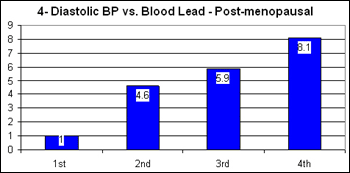
OK – so an increasing blood Lead levels within the “safe” range is associated with an increasing risk of hypertension, clearly not an increasingly “safe” disease state, but why is the link between blood Lead level and hypertension stronger in post-menopausal women then in pre-menopausal women? You’ve already figured out the answer. It’s not just the blood Lead, but the total body content of Lead, that is the driving force underlying the hypertension. In pre-menopausal women, bone turnover is minimal, so there is little correlation between body Lead content, best measured as bone Lead, and the blood Lead level that this research group measured, so the link between hypertension and blood Lead will be weak. Following menopause, when bone turnover increases, bone Lead accumulated over the decades is released. At this point, blood Lead levels will more accurately reflects total body Lead stores, and this Lead, now in the circulation, is more free to damage the blood vessel wall and kidneys; this Lead that is now being rapidly released into the circulation is now free to rapidly drive up your blood pressure. I have often wondered why blood pressure values “spike” in my female patients in their late 40’s and early 50’s, or why their pre-existent hypertension becomes more difficult to treat, but now I know – it’s the Lead stupid! Now you know. Don’t be stupid, get the Lead out of your body, and get it out now, well before you get sick.
I think I’ve made my point that Lead is a primary, if not the most important, cause of hypertension in the United States. Now let’s examine the link between body Lead burden and kidney disease. The Normative Ageing Study researchers also looked at the relationship between blood Lead level in men and their level of kidney function. We measure kidney function in terms of the serum Creatinine. Creatinine is manufactured in muscle at a constant rate, released into the circulation, and then cleared from the circulation by the kidneys. Thus as kidney function declines, the serum Creatinine goes up. A normal Creatinine is <1.5 mg/dl (this may vary from lab to lab), while a Creatinine of 2 to 4 reflects moderate kidney dysfunction. Individuals with Creatinine levels in the 4 to 6 range are experiencing symptoms, and at a level above 6 mg/dl dialysis is typically necessary – so we want to see a low serum Creatinine. A rising Creatinine reflects a deteriorating kidney situation, while any intervention that causes an elevated Creatinine to fall is having an important, positive impact on your health.
For the entire group, the average serum Creatinine level was 1.2 mg/dl, with 5th and 95th percentile values of .9 and 1.8 mg/dl, respectively. The average blood Lead level was 9.9 ug/dl, with 5th and 95th percentile values of 3.3 and 20.2 ug/dl.. The researchers first looked at the relationship between blood Lead and the level of kidney function at a single point in time (chart 5). Surprise, surprise, as blood Lead levels rise, even within the “safe” range, kidney function falls. The drop off in kidney function, reflected as a higher Creatinine, as blood Lead levels rise, may not, at first glance, look like much, but it looks like a lot if you consider that for every 0.1 mg/dl rise in creatinine, kidney function is deteriorating by 10%. 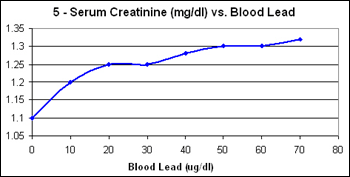
Kidney function declines with advancing age; this means that we expect to see some rise in the creatinine value as you get older. In chart 6, the rise in creatinine with age is depicted, in relation to whether the subjects were in the lower (blue) or upper (red) quartile for blood Lead at baseline. As you can see, a higher Lead level accelerates the decline in kidney function that occurs with ageing. The deterioration in kidney function that occurs with ageing in Americans may simply reflect a longer time period that you have been exposed to toxic metals such as Lead, toxic metals that you cannot get rid of, toxic metals that accumulate within your cells and within your organs, toxic metals that damage your biochemistry and cause disease states. In terms of declining kidney function, a 10-fold increase in blood Lead level was equivalent to 20 years of ageing – this is not the way to age gracefully. 
We’ve established that Lead, whether measured as blood Lead, or more accurately as bone Lead, is associated with high blood pressure and kidney dysfunction, and that levels in the “safe” range are anything but safe. Cadmium and Mercury may also cause hypertension and kidney disease, and they synergize with Lead. What does this mean? This means that the rise in blood pressure that we see with ageing in America, this incredibly common age-related disease state that we call essential hypertension, is probably due primarily to cumulative heavy metal overload. Heavy metals cause hypertension and damage the kidneys due to:
a) Direct toxicity to the cells of the artery wall and kidneys,
b) Heavy metals cause free radical stress, which also damages the artery wall and kidneys, and which also inactivates Nitric Oxide, the primary blood vessel dilating molecule manufactured by the artery wall, and
c) Heavy metals displace BP-lowering nutritional metals such as Calcium and Magnesium from our cells.
This same pathology is going on in every cell in the body, and is playing a role in all of the disease states that we associated with ageing, but here we’re talking only about hypertension and kidney disease. So what can we do?
The answer is that we can remove the heavy metals from our cells, reversing the biochemical anarchy that the metals are causing, and when we do this we can usually stabilize, and often even reverse, the abnormalities in blood pressure and kidney function that were brought on by the toxic metals. Removing heavy metals from the cells of humans is generically called “Chelation Therapy” or “Heavy Metal Binding Medicine”. This approach involves the administration, either oral or IV, of a heavy metal binding agent. The most commonly used metal binding agents are EDTA, DMSA, and Vitamin C, and guess what, all three are included in the Med Five. Let’s see what happens when we administer EDTA to individuals with established kidney disease.
This study was carried out in patients with moderate renal insufficiency (creatinine between 1.5 and 3.9 mg/dl), residing in Taipei, a large, industrial city in Taiwan. Body Lead burden was estimated based on the result of an IV EDTA challenge study, where urine Lead is measured over 72 hours following the intravenous administration of 1,000 mg of EDTA. The EDTA challenge test is considered to be the best laboratory measure of body Lead burden, and when used to evaluate Lead status in individuals with hypertension and/or kidney disease, often returns abnormal.
The 64 subjects involved in this study were not considered to be “Lead toxic”, at least not by standard medical criteria. None had an occupational history where Lead exposure was likely, and in all 64, their post-IV EDTA urine Lead level was <600 ug, considered to be “within normal limits”. In other words, these were individuals with kidney disease and “normal” or “not unexpected” Lead burdens. Over the first two years of this study, no action was taken, allowing the researchers to record the natural history of the kidney disease state. At the two year point, the subjects were divided at random into a placebo group, where each subject received 200 cc of salt water IV once a week over three months, or a Chelation Therapy group, where each subject received 1,000 mg of EDTA mixed in 200 cc of salt water every week until their post-EDTA urine Lead level fell to less than 60 ug. The subjects were followed for an additional two years; during this time period the placebo assigned subjects received periodic salt water placebo IVs, and the Chelation Therapy assigned subjects received IV EDTA if their post-EDTA urine Lead level remained above 60 ug. All 64 subjects received the same standard therapy appropriate to their health status. This study was double blind, meaning that neither the subjects nor the researcher knew who was getting IV salt water and who was getting IV salt water with EDTA. So what happened?
With three months of Chelation Therapy, the intentional removal of Lead, a known toxin, from the bodies of these poor souls with kidney dysfunction, the average blood Lead level in the EDTA-treated subjects fell from 6.1 to 3.9 ug/dl (both values well within the “safe” range), and their post-EDTA 72 hour urine Lead level fell from 151 to 43 ug. In the standard therapy plus salt water placebo control group, Lead levels and Lead burden remained unchanged, just as you would expect. Well that’s nice, and that makes sense, but what affect did all this Chelation Therapy have on the subjects underlying kidney function? Chart 7 describes the rate of deterioration over time of the Glomerular Filtration Rate, the most important index of overall kidney function, in the 64 patients studied (control patients in red and Chelation patients in blue). Remember that months 24 were observational; neither group received any new therapy. The patients received IV salt water or IV salt water with EDTA over months 25-27, while during months 28-51 the subjects received either salt water or additional IV EDTA as needed to keep their post-EDTA urine Lead level below 60 ug. 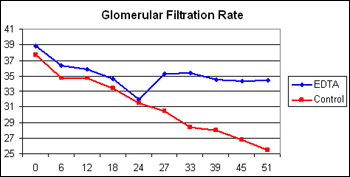
A normal Glomerular Filtration Rate is 100; as you see these 64 subjects all began the study with a moderate level of kidney function impairment. Neither group received any new treatments over the 24 month observation period, and in both groups kidney function declined, by 3.4% per year in the to-be-treated with EDTA group and by 3.0% per year in the to-be-treated with salt water group. Months 25-27, the placebo patients received salt water, and their GFR values continued to decline. The EDTA group received EDTA, which removed Lead (and Cadmium, Nickel, and Aluminum, but these metals were not measured in this study), and their GFR values improved. This makes sense – if Lead if toxic to the kidney, and we know that it is, then by removing Lead from the kidneys, we would expect kidney function to improve – and it did, the GFR value rose from 32 to 36! Now let’s focus on months 27 through 51. During this time period 19 of the 31 Chelation Therapy patients received just one more IV EDTA treatment; the initial three months of IV EDTA had basically gotten the job done. The control patients continue to demonstrate the steady downhill course that we expect to see in kidney patients, while in the EDTA patients, who had been “de-leaded”, kidney function stabilized. The control patients continued their downhill spiral which will end with dialysis and/or a kidney transplant, while the “de-leaded” patients stabilized. Three months of IV EDTA would cost about $1,000, less than a day in the hospital; it’s also less uncomfortable to the patient than dialysis or kidney transplantation.
What does this mean – it means that just as with your kid’s IQ, just as with your wife’s blood pressure, just as with your serum creatinine value, when it comes to kidney function, there is no “safe” level of Lead. The “safe” level of Lead displayed by these kidney patients was greatly aggravating their kidney dysfunction; in some Lead was likely the primary cause of their kidney disease.
The studies outlined above were all published in major medical journal, journals that are widely read by American physicians, but their importance has been largely ignored. While science tells us that Lead is poisoning the brains of our children, driving up our blood pressure, and destroying our kidneys, American physicians continue to measure blood Lead levels, which invariably comes back in the “safe” range, and they then counsel you that “Lead is not a problem”. American physicians continue to miss the boat, allowing you to drown. So what can you do?
If you feel that you might be Lead overloaded, seek out a physician trained in heavy metal toxicology (phone numbers below). 2nd, look for sources of heavy metal exposure in your environment. Third, begin now on a program of heavy metal removal; this is where we come in. Rejuvetate Life was designed as a means of “fighting back” against the heavy metal overload state that isn’t biologically normal, but which is now normative, in Americans. We are not presenting Rejuvetate Life to you as an “antidote” or “cure” for disease states associated with heavy metal toxicity – here you must work hand-in-hand with an appropriately trained physician. We are presenting Rejuvetate Life to you as a means of decreasing your heavy metal burden, as a means of preventing the development in you (and your children – remember that heavy metals cross freely from Mother to Child across the placenta) of a heavy metal overload state. Mother Nature intended us to be totally free of heavy metals such as Lead, and that is what we want for you.
James C. Roberts MD FACC for Med Five Inc. Last updated 1/1/04
To find a physician trained in heavy metal toxicology, please call:
a) ICIM (International College of Integrative Medicine) at 866-464-5226.
b) ACAM (American College for Advancement in Medicine) at 714-583-7666.
Do not use this product if you are pregnant or nursing. If you are under a physician's care or taking medication, consult your health professional before taking this product. If you are taking or intend to take other detoxification treatments while on MedFive, please discuss this with your physician first. You should take minerals and vitamins when using this product – supplements and medications should be taken at least two hours apart from Step Two. This product is not intended to diagnose, treat, cure, or prevent any disease.
It is not necessary to take other detox programs while on Med Five.
|
Science Topics
 Cadmium Cadmium
 Cholesterol Transport Cholesterol Transport
 EDTA EDTA
 Free Radicals Free Radicals
 Lead Lead
 Lipoic Acid Lipoic Acid
 Vitamin C Vitamin C
|











